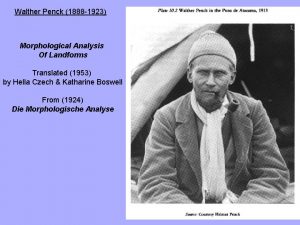The Geographic Cycle WM Davis William Morris Davis












- Slides: 12

The Geographic Cycle WM Davis

William Morris Davis -Born February 12, 1850, Philadelphia, PA -Graduated from Harvard 1869 -Instructor of geology at Harvard, 1879 (never finished his Ph. D. ) -In addition to work on physical geography, Davis was very involved in educational theory and professional association (founded the Association of American Geographers, 1904) -Died February 5, 1934, Pasadena, CA Source: http: //www. wikipedia. org

Historical Context • Development of geology as a separate branch of science -1775 to 1830. • Hutton (1726 -1797) -uniformitarinism. John Playfair (1748 -1819) publicised Hutton's theories and added further ideas. • Lyell published the classic textbook, 'Principles of Geology', in 1830 -1833. • William Smith (1769 -1839)-stratigraphical successions based on fossils • By the middle of the Nineteenth Century, the general geological time scale based on fossils and stratigraphic mapping was established. • Geomorphological studies were advanced by the work of Agassiz, who in the 1840 s recognised the effects of Pleistocene glaciation in Europe and the USA. • Later Gilbert and Powell made classical studies on arid erosion in the western USA. • The strongest influence up to 1900 was the work of W. H. Davis, an American who worked both in USA and Europe and who first defined the cycle of erosion. Information provided by: http: //www. minerals. nsw. gov. au James Hutton by Abner Lowe

Landscape is a Function of these Geographical Controls • Structure –Horizontal (plains, etc. ) –Disordered (mountains, etc. ) • Process • Time

The Landscape W. M. Davisian Analysis Rejuvenation “Youth” uplift base level fall relief increase; “Maturity” then, decrease “Old Age”

In the 1960 s and 1970 s, Henry Besairie mapped much of the central plateau of Madagascar as dissected peneplain…discuss! (Google Earth)

Facts of Observation (pg. 484) • The explorer of the Earth should be as fully convinced of this principle (that geolographical landforms have meaning), and as well prepared to apply it, as the explorer of the sky is to carry physical principles to the furthest reach of his telescope, his spectro- scope, and his camera. The preparation of route-maps ……is only the beginning of exploration, which has no end till all the facts of observation are carried forward to explanation.

Challenges Geographers to become “Wasteformologists” • “As a consequence, the scheme gains a very " theoretical" flavour that is not relished by some geographers, whose work implies that geography, unlike all other sciences, should be developed by the use of only certain ones of the mental faculties, chiefly observation, description, and generalization. ” (483)

“Systematic Investigation of Land-forms” (pg. 498) • Its value to the geographer is not simply in giving explanation to land- forms; its greater value is in enabling him to see what he looks at, and to say what he sees. • …Significant features are consciously sought for; exploration becomes more systematic and less haphazard…. . "A hilly region" brings no definite picture before the mental eyes. "A maturely dissected upland" suggests a systematic association of well-defined features; ….

Discussion Points • “So with waste-sheets; they normally begin to establish a graded condition at their base, and then extend it up the slope of the valley side whose waste they ‘drain’. ” (pg. 496) – Rills on hillslopes also graded in old age? (489) • Stream terminology – “consequent”, “insequent”, etc. (pg 490 -493) • Figure 1?

Romans? • “To look upon a landscape of this kind without any recognition of the labour expended in producing it, or of the extraordinary adjustments of streams to structures, and of waste to weather, is like visiting Rome in the ignorant belief that the Romans of to-day have had no ancestors. “

 William morris golden type
William morris golden type Wallpaper - hyacinth, pattern #480
Wallpaper - hyacinth, pattern #480 Morris art nouveau
Morris art nouveau The nature of gothic william morris
The nature of gothic william morris William davis primary school
William davis primary school Fluvial cycle of erosion by davis and penck
Fluvial cycle of erosion by davis and penck Basal forebrain
Basal forebrain V5-7gzofadq -site:youtube.com
V5-7gzofadq -site:youtube.com Morris fuller benton
Morris fuller benton Morris yock
Morris yock Horace morris but mostly dolores
Horace morris but mostly dolores Chiene line
Chiene line Ananya tripathi trader
Ananya tripathi trader






















